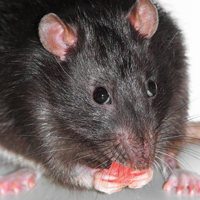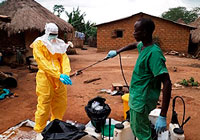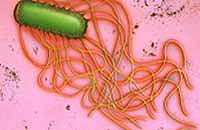Already many generations of people do not remember how many times the scale of the plague epidemics were. About how this disease flows and where it comes from, read in this article.
Content
 Plague, acute infectious disease caused by Yersinia Pestis bacteria and manifested in two main forms - bubonic and pulmonary. In nature, the plague is common among rodents, from which a person is transmitted in the bite infected fleas. The prevailing form of the plague in humans - the bubonic plague is characterized by inflammation of lymph nodes (most often in collaboration); In appearance, enlarged lymph nodes resemble beans, from where the name of the disease occurred: «Jumma» - Arab. «bean».
Plague, acute infectious disease caused by Yersinia Pestis bacteria and manifested in two main forms - bubonic and pulmonary. In nature, the plague is common among rodents, from which a person is transmitted in the bite infected fleas. The prevailing form of the plague in humans - the bubonic plague is characterized by inflammation of lymph nodes (most often in collaboration); In appearance, enlarged lymph nodes resemble beans, from where the name of the disease occurred: «Jumma» - Arab. «bean».
The main carriers of the pathogens of the plague are rodents, mainly rats, earth squirrels, coitots, gopters, tushkars - just about 300 species. A man of the plague is always transmitted from the natural tank - from infected animals. In cities, plague bacteria are preserved among rats and mice; It is the rats that serve as the main source of human infection. In rural areas, the main carriers of infection are field or forest rodents living in this area. In some regions of Siberia, Manchuria, South Africa, South America and the United States, the incidence of plague is endemic in nature: cases of infection are limited to certain areas of animal distribution. In the US, the diseases were marked mainly in the southwestern part of the country: in California, Nevada, Colorado, Arizona and New Mexico.
It is believed that cases of Chuma's disease take place in almost every country, and relatively high incidence is noted in India, Burma, Vietnam, Brazil, Peru, Tanzania, in Madagascar and the Philippines. Susceptibility to the plague does not depend on race, age or gender. The bubonic plague is more common in areas with an average air temperature below 27 degrees Celsius; At 29 degrees Celsius of the epidemic begin to decline. The pulmonary form of plague is marked mainly in the cool seasons of the year and is found mainly in countries with a moderate wet climate. However, in 1994 there was an outbreak of the pulmonary plague in susta (India) located in the tropical part of the country.
The bubonic plague is transmitted parasitating on the rats of fleas of the genus Nosopsyllus (Ceratophyllus) and Xenopsylla. Flowing flea fleas pole iRritans is also considered as a possible plague carrier. Epidemics of the plague in humans are usually preceded by epizootia (epidemics in animals). Bubonic plague, not complicated by pulmonary manifestations, is usually less inclied and is transmitted in the bite of rat flea. However, the infection of the plane is possible and in direct contact with the patient or with the discharge of the patient (human or rat). Pulmonary plague is distributed by air-drip and extremely infection.
The incubation period lasts 2-10 days. For bubonic plague, a sudden start in the form of a strong chill, a rapid increase in temperature, strong headaches, dizziness, thirst, vomiting. In the nearest flea bite of regional lymph nodes, inflammation is developing; they increase in size, forming bubo, and become very painful. Most often affected lymph nodes of the groin area, but sometimes also axillary, cervical and other lymph nodes.
As a result of the strongest intoxication, the patients are rapidly developing the condition of complete prostration (stupidity and inhibition), the confusion and coma confusion. Part of the patients, on the contrary, arise excitement, nonsense, hallucinations, the desire to escape. Plague - a short disease: death or fracture in disease occur within a few days. With a septic form of plague, the clinical picture of infectious-toxic shock develops so quickly that patients die from the phenomena of cardiovascular insufficiency and hemorrhagic syndrome before the development of bubons. Bubonic plague can be complicated by pneumonia, which at one time almost always led to death. With large bubonic plague epidemics, mortality reached 90%.
The pulmonary form of plague is characterized by the fact that already during the first day after a sudden principle with a strong chill, a rapid increase in the temperature appear in the chest and the bloody foam of the wet. The course of this form of the disease is very fast: the patients died before the era of antibiotics in 2-4 days. Currently, if the disease can be lately recognized and start the introduction of antibiotics in the first 24 hours, in many cases recovery comes.
With the beginning of using antibiotics, the disease forecast has become more favorable, although there are no absolutely reliable means of treatment. It is very important to start treatment as soon as possible. Streptomycin is most effective with all formations of plague and has a smaller side effect in comparison with other antibiotics. Those who go to «Plague areas», Daily prophylactic tetracycline intake during the period of possible infection is recommended.
Plague included in a group of specially dangerous infections. Therefore, measures warning its distribution are of paramount importance. In endemic areas it is necessary to carry out the destruction of rats. On cases suspicious about the plague, you must immediately report to local health authorities. Patients with pulmonary plague should be immediately isolated from others, since this form of infection is the most infection. All in contact with the patients are recommended to subjected to a quarantine examination.









